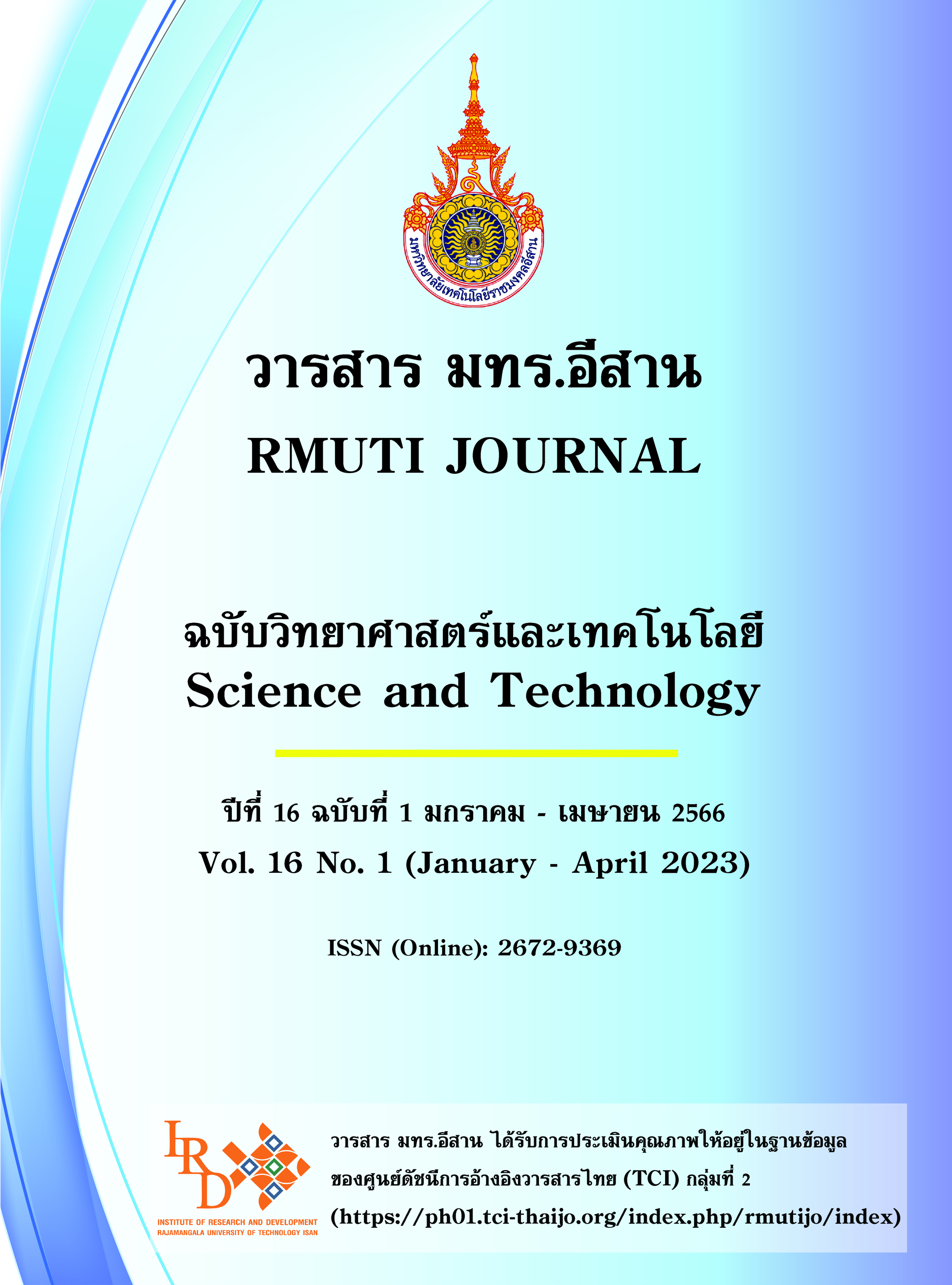Performance and Economics Evaluation of Bifacial Solar Panel Installation on the Roof of Kanchanaphisek King Rama 9th Sports Center Building, Maejo University
Main Article Content
Abstract
The research aimed to investigate the performance and economics of using bifacial PV modules on a model building's roof. The bifacial PV modules used in the study were monocrystalline, half-cut cell type, with a power rating of 430 W per panel. The study was conducted on a white painted concrete surface, and the panel's height was adjusted to 0.50, 1.00, and 1.50 m, while the installation angle was adjusted to 15, 18, and 21°, respectively. The study found that at a panel height of 1.50 m and an installation angle of 15°, a bifacial PV module produced a maximum power of 424.88 W with a power generation efficiency of 21.82 %. Additionally, the study derived a predictive power correlation equation to forecast the electric power production throughout the year based on experimental data. The study further investigated the case of installing 124 bifacial PV panels on the roof of Zone A of Kanchanaphisek King Rama 9th Sports Center Building Center, Maejo University, using the correlation equation to predict the electricity production. The system was found to produce 130,479.36 kWh/year of electricity with an average system performance (performance ratio) of 1.15. The total investment required for the installation was 1,890,699.50 baht, and the payback period was 3.95 years, with a net present value of 1,601,144.48 baht and an internal rate of return of 16.26 %.
Article Details

This work is licensed under a Creative Commons Attribution-NonCommercial-NoDerivatives 4.0 International License.
References
Nopakun, D. (1993). Climatolygy. Chulalongkorn University Bangkok. (in Thai)
Shoukry, I., Libal, J., Kopecek, R., Wefringhaus, E., and Jürgen, W. (2016). Modelling of Bifacial Gain for Stand-Alone and In-Field Installed Bifacial PV Modules. Energy Procedia. Vol. 92, pp. 600-608. DOI: 10.1016/j.egypro.2016.07.025
Yusufoglu, U. A., Lee, T. H., Pletzer, T. M., Halm, A., Koduvelikulathu, L. J., Comparotto, C., Kopecek, R., and Heinrich, K. (2014). Simulation of Energy Production by Bifacial Modules with Revision of Ground Reflection. Energy Procedia. Vol. 55, pp. 389-395. DOI: 10.1016/j.egypro.2014.08.111
Katsaounis, Th., Kotsovos, K., Gereige, I., Basaheeh, A., Abdullah, M., Khayat, A., Alhabshi, E., Al-Saggaf, A., and Tzavaras, A. E. (2019). Performance Assessment of Bifacial c-Si PV Modules Through Device Simulations and Outdoor Measurements. Renewable Energy. Vol. 143, pp. 1285-1298. DOI: 10.1016/j.renene.2019.05.057
Sun, X., Mohammad, K., Deline, C., and Mohammad, A. (2018). Optimization and Perfomace of Bifacial Solar Modules: A Global Perspective. Applied Energy. Vol. 212, pp. 1601-1610. DOI: 10.1016/j.apenergy.2017.12.041
LG Electronics Inc. (2017). Bifacial Design Guide. Brochure. Seoul. Korea: Author
Wetchaka, K. (2017). Performance Analysis of 50 kWp Floating PV System. M.Eng. Electrical Engineering. Faculty of Engineering. Rajamangala University of Technology Thanyaburi. (in Thai)
Kanta, N., Polvongsri, S., Intaniwet, A., and Mongkon, S. (2021). The Effect of Reflective Surface on Bifacial Photovoltaic Efficiency. In 14th Thailand Renewable Energy for Community Conference (TREC-14). Chiangmai: Maejo University. pp. 518-524 (in Thai)
Chaiyat, N. (2019). Themal Rewewable Energy Technology. Renewable Energy School. Maejo University Chiangmai (in Thai)
Chaichana, C., Kiatsiriroat, T., and Nuntaphan, A. (2010). Comparison of Conventional Flat-Plate Solar Collector and Solar Boosted Heat Pump Using Unglazed Collector for Hot Water Production in Small Slaughterhouse. Heat Transfer Engineering. Vol. 31, Issue 5, pp. 419-429. DOI: 10.1080/01457630903375475
Thai Meteorological Department. (2022). Climate. Access (31 March 2022). Available. (https://www.tmd.go.th/province_weather_stat.php?StationNumber=48327)
HUAWEI. (2019). SUN2000-36KTL-M3. Access (23 September 2022). Available (https://www.solar.huaweic.com)
Design and Construction, Office of the Basic Education Commission. Ministry of Education. (2022). 2 Architecture, 2.10 Painting. Construction Materials and Labor Cost for the year 2022. pp. 47-49 (in Thai)
Krungthai Bank. (2021). Loan Interest Rates. Access (30 September 2022). Available (https://krungthai.com/th/rates/viewdetail/4)
Mae Jo University's Average Electricity Cost 115 kV. (2020). Annual Report (2020). Chiangmai: Maejo University (in Thai)


